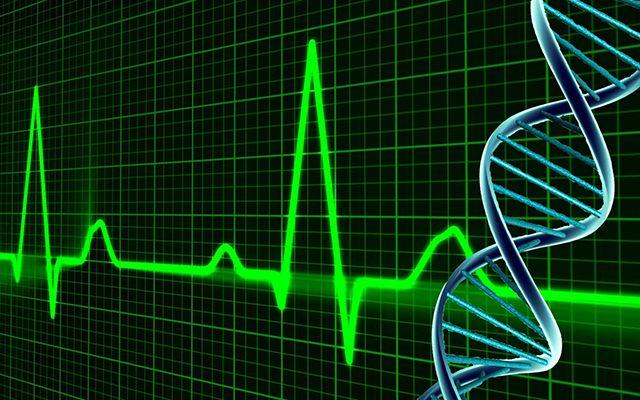
Credit: UC San Diego Health Sciences
Genome-wide association studies have uncovered more than 500 genetic variants linked to heart function, everything from heart rate to irregular rhythms that can lead to stroke, heart failure or other complications. But since most of these variations fall into areas of the genome that don’t encode proteins, exactly how they influence heart function has remained unclear.
By examining heart cells derived from the skin samples of seven family members, researchers at University of California San Diego School of Medicine have now discovered that many of these genetic variations influence heart function because they affect the binding of a protein called NKX2-5.
The study is published September 30, 2019 in Nature Genetics.
NKX2-5 is a transcription factor, meaning it helps turn “on” and “off” genes — in this case, genes involved in heart development. To do this, NKX2-5 must bind to non-coding regions of the genome. That’s where genetic variation comes in.
“NKX2-5 binds to many different places in the genome near heart genes, so it makes sense that variation in the factor itself or the DNA to which it binds would affect that function,” said senior author Kelly A. Frazer, PhD, professor of pediatrics and director of the Institute for Genomic Medicine at UC San Diego School of Medicine. “As a result, we are finding that multiple heart-related traits can share a common mechanism — in this case, differential binding of NKX2-5 due to DNA variants.”
The study started with skin samples from seven people from three generations of a single family. The researchers converted the skin cells into induced pluripotent stem cells (iPSCs) as an intermediary. Like all stem cells, iPSCs can both self-renew, making more iPSCs, and differentiate into a specialized cell type. With the right cocktail of molecules and growth factors, the researchers directed iPSCs into becoming heart cells.
These heart cells actually “beat” in the laboratory dish, and still bear the genetic and molecular features of the individuals from which they were derived.
Frazer and team conducted a genome-wide analysis of these patient-derived heart cells. They determined that NKX2-5 can bind approximately 38,000 sites in the genome. Of those, 1,941 genetic variants affected NKX2-5 binding. The researchers investigated the role of those variants in heart gene function and heart-related traits. One of the genetic variants was associated with the SCN5A gene, which encodes the main channel through which sodium is transported in heart cells.
Since related individuals tend to share similar genetic variants, the team was able to validate their findings by analyzing the same variants in multiple samples.
“People typically need a large number of samples to detect the effects of common DNA variants, so we were surprised that we were able to identify with high confidence these effects on NKX2-5 binding at so many sites across the genome with just few people,” said first author Paola Benaglio, PhD, a postdoctoral researcher in Frazer’s lab.
Yet, she said, this finding may just be the tip of the iceberg.
“There are probably a lot more genetic variants in the genome involved with NKX2-5 as well as with other important cardiac transcription factors,” Frazer said. “We identified almost 2,000 in this study, but that’s probably only a fraction of what really exists because we were only looking at seven people in a single family and only at one transcription factor. There are probably many more variants in gene regulation sites across the entire population.”
Not only does the team plan to further investigate cardiovascular genetics, they also have their sights set on other organ systems.
“We are now expanding this same model system to look at many different transcription factors, across different tissue types, such as pancreas and retina epithelia, and scaling it up to include more families,” Benaglio said.
###
Co-authors include: Agnieszka D’Antonio-Chronowska, William W. Young Greenwald, Margaret K. R. Donovan, Christopher DeBoever, He Li, Frauke Drees, Sanghamitra Singhal, Hiroko Matsui, Kyle J. Gaulton, Erin N. Smith, Matteo D’Antonio, Michael G. Rosenfeld, UC San Diego; Wubin Ma, Feng Yang, Howard Hughes Medical Institute and UC San Diego; Jessica van Setten, University Medical Center Utrecht; and Nona Sotoodehnia, University of Washington.
Media Contact
Heather Buschman, PhD
[email protected]
Related Journal Article
http://dx.




